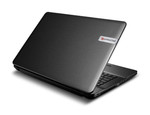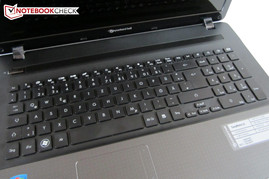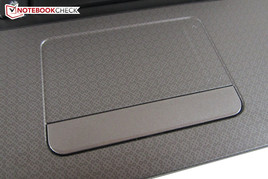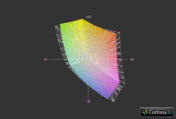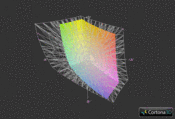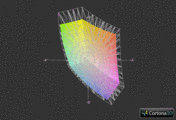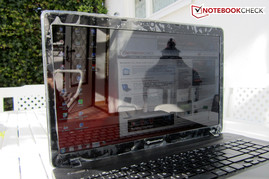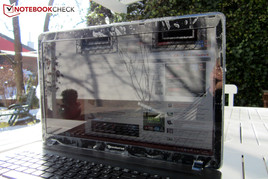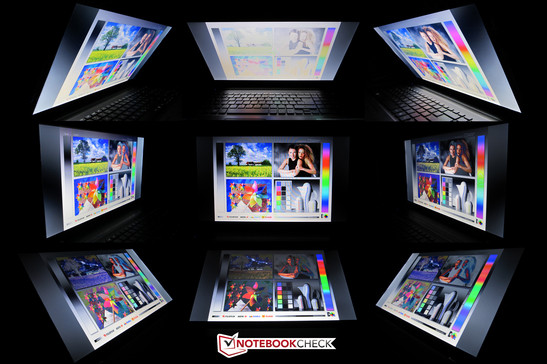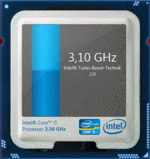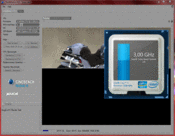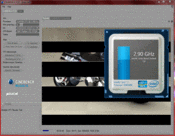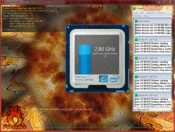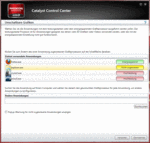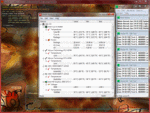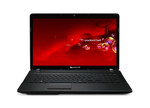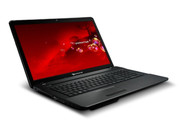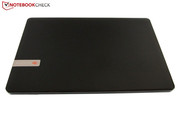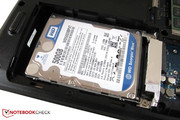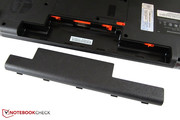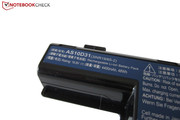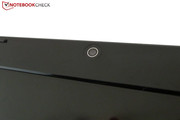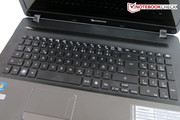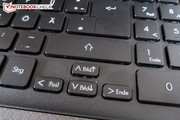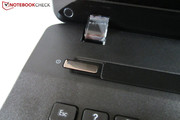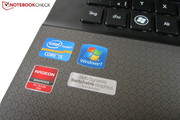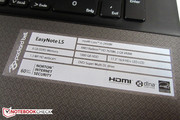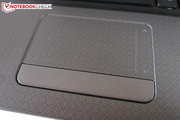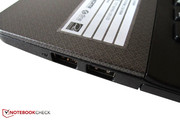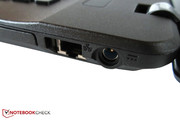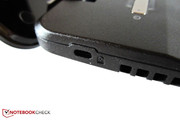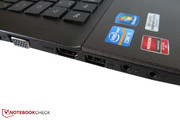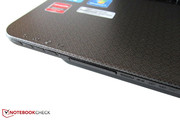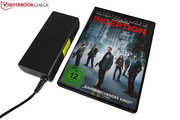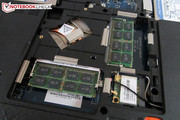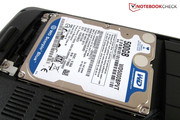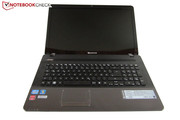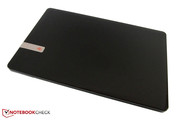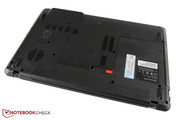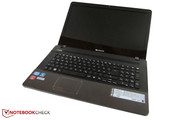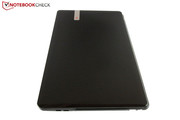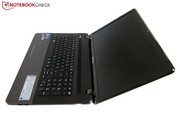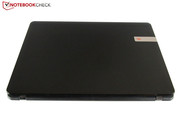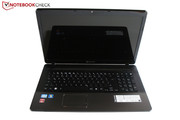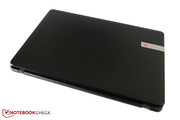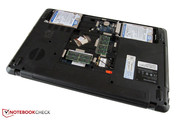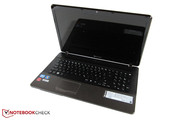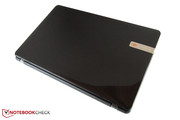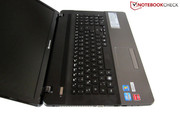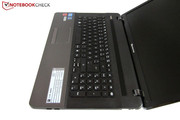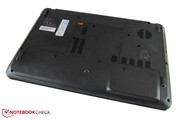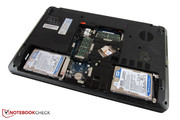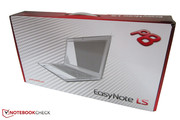Review Packard Bell EasyNote LS11HR-167GE Notebook
The name Packard Bell has long stood for attractive and fairly-priced multimedia devices. With the EasyNote LS11HR-167GE the manufacturer again rightly claims its reputation. The 17-inch all-rounder has powerful and perfectly compatible mid-class components at its command.
Let's jump right in with the highlight of the notebook: the Radeon HD 7670M is actually only a renamed HD 6670M, but thanks to its good performance, the DirectX 11 graphics card isn't at all left behind popular Nvidia models like the GeForce GT 630M – quite the opposite.
After that comes a dual-core processor by Intel. The 2.5 to 3.1 GHz speedy Core i5-2450M masters almost every task with bravura. Eight GByte DDR3-RAM and two 500 GByte HDDs aren't exactly meager, either. A DVD-burner completes the hardware package. In the realm of software Packard Bell puts its confidence in the Windows 7 Home Premium 64 bit.
And what's all the fun cost? At the time of review the EasyNote LS11HR-167GE was available for about 700 Euros.
Case
The black case is inobtrusive in various respects. A weight of 3.1 kg and a measurement of 414 x 275 x 37 mm are typical for a 17-inch device. Also in its technical design the EasyNote LS11 makes a modest impression. The shaping orients itself towards the current notebook standard, dark plastic surfaces dominate.
Little details like the patterned (and, because of its piano-finish look, extremely sensitive) notebook lid, however, makes the multimedia device stand out from the conventional crowd. In particular, the silver-gray palm rest brings fresh wind to the look. In terms of quality, the 17-incher is alright. The plastic surfaces are very well manufactured, even down to the transition between the lid and the frame of the screen.
The notebook reveals its weaknesses in the area of stability. As with many other devices, with two hands the monitor can be substantially bent. The top yields itself noticeably, mainly in the area of the battery (rear) and in the area of the DVD drive (right). The bottom, on the other hand, is relatively stable.
In terms of both the hinges, the attribute wobbly would apply. If you shake the base (simulating earthquake tremors), the monitor distinctly rocks back and forth. Still, the screen can be flipped open with one hand. Along with better hinges, in the future we would like to see completely matte surfaces.
Connectivity
Ports
Frustrating: Though the (more or less structurally identical) EasyNote LS11HR-050GE that we reviewed a few months ago could offer two USB-2.0 ports and one modern USB-3.0 port, the new LS11HR-167GE has to make do with three USB-2.0 ports.
The rest of the available connections have remained the same. Thus, the left side is equipped with a Kensington Lock, VGA and HDMI output, and two audio connections (headphones + microphone). The front side contains a 5-in-1 card reader, the right side a RJ-45 Gigabit-LAN port and the power input.
The positioning of the connections is something Packard Bell should think over again. Although most of the ports are intuitive and comfortably accessible, when cables are plugged in, the use of a mouse is difficult (there are collisions).
Communication
Those who like to surf the internet wirelessly will be happy about the WLAN module (Atheros AR5B97). Bluetooth is not supported.
Maintenance
In order to access the radio module, the main memory and the hard drive, all you have to do is remove three screws from the bottom of the case and take off the maintenance lid. Fans, the processor, and the graphics card are not directly accessible.
Software
Packard Bell shows no mercy and crams the notebook full of all sorts of Bloatware. Why are we aggravated about free software? Well, the practical uses of some of the programs tend towards zero. Moreover, because of them Windows is unnecessarily limited. At least a few features are worth mentioning: some readers are bound to sit up and take notice of "Adobe Photoshop Elements 9", "Adobe Premiere Elements 9" and "Nero Multimedia Suite 10 Essentials".
Accessories
In order to offer the notebook as cheaply as possible, Packard Bell economizes its scope of supply: a power supply, battery, Getting Started booklet and warranty manual will have to suffice for the buyer. The system recovery is located on the hard drive, as usual, and the option exists for it to be burned to DVDs.
Warranty
Unsurprisingly, the warranty goes out two years (pick-up & return service).
Input Devices
Keyboard
The matte-black keyboard we'd describe as successful. By virtue of the so-named chiclet design (free-standing keys), you rarely hit the next key over. Despite the spaces in between, the keys are properly dimensioned at 15 x 15 mm. Also in terms of layout, there's hardly anything anyone would criticize. Further plus points are the dedicated number block and the respectable typing feel (decent pressure point & stroke).
Uncommon: the comfort functions (brightness, volume, etc.) are activated without a simultaneous press of the Fn key. This behavior can be changed in the BIOS settings, however (during the booting process, press F2 / Main / Function Key Behavior). Illumination is missing, unfortunately.
Touchpad
The deactivatable touchpad cuts a fine figure, too. Not least, thanks to the many gestures (scroll, page turning, rotate and zoom with two fingers) the Windows daily routines can be executed effortlessly with your hand. A separate scrolling area is another thing you don't see every day. Another strength is the smooth surface that you can glide on very comfortably. What's more, the touchpad usually reacts with precision. With a measurement of 86 x 45 mm, the size is in the mid-range. Unfortunate: the two mouse buttons behave somewhat spongily.
Display
Now we come to the biggest weak point of the EasyNote LS11HR-167GE: the display. Packard Bell uses a 17-inch glare panel, which with 1600 x 900 pixels offers the ideal mixture of lots of work space and lower consumption of resources. Hollywood blockbusters will profit from the 16:9 format. Like most competitors, however, the manufacturer pays far too little attention to the picture quality.
| |||||||||||||||||||||||||
Brightness Distribution: 80 %
Center on Battery: 264 cd/m²
Contrast: 240:1 (Black: 1.1 cd/m²)
57.1% AdobeRGB 1998 (Argyll 3D)
82.6% sRGB (Argyll 3D)
55.3% Display P3 (Argyll 3D)
With the Chi Mei N173FGE-L21, our test device contains a terribly inferior panel. Especially at night, dark film and game sequences make a pretty gray impression. The responsibility for that lies on the high black value of about 1.1 cd/m². For a rich black, the value can't surpass 0.4 cd/m².
With a contrast of a scarce 240:1, a cheap display is just as suggested. For comparison: high-quality models reach a contrast of over 700:1 (see, for example, the Asus N75SF-V2G-TZ117V). Due to the shiny surface, the colors are still useful. The monitor performs well only in terms of brightness: 243 cd/m² moves it over the notebook average.
Despite its irreproachable brightness, the EasyNote LS11HR-167BE is not convincing for outdoor use. As expected, the glossy surface causes strong and unpleasant reflection. If you're unlucky, you might also be confronted with reflections in interior spaces in the daytime. A matte screen would make the user's choice of location considerably easier.
The 17-incher has to pocket more criticism for the small viewing angle. Even if you're sitting in an optimal position in front of the monitor, in some picture areas changes in brightness appear. Thus while watching a film, for instance, the top sections appear darker than the bottom ones.
All in all the picture quality is disappointing on a broad level. For games or videos, it would be better to hook up an external monitor. Good displays under the price range of 1000 Euros are few and far between (the Schenker XMG A501 is one of the few exceptions).
Performance
Processor: Intel Core i5-2450M
To fit with the mid-range graphics card, the EasyNote LS11HR-167GE has a dual core CPU at its command. The Core i5-2450M is based on Intel's successful Sandy Bridge architecture and is manufactured in accordance with the 32 nm procedures. Like the other Core i5 models the dual-core contains 624 million transistors (995 million in the quad-core) and a three MByte L3 cache.
One of the most important features is the hyper threading technology, which makes it possible for the Core i5-2450M to process four threads in parallel. But the processor doesn't become a real quad-core that way. Although the Core i5-2450M with 2.6 GHz in its initial condition already reaches relatively high speeds, Intel integrates its proven Turbo Boost technology. At a max of 3.3 GHz, it can easily match the desktop competition.
Intel even gives the Sandy Bridge model a small graphics chip named the HD Graphics 3000 (650-1300 MHz), that can be used optionally instead of a dedicated graphics card. In light of the equipment and the afforded performance, a TDP of 35 watts is definitely alright.
Turbo Boost
On the test device, the automatic overclocking functioned flawlessly. Under load the turbo was constantly active and accelerated the Core i5-2450M by several 100 MHz. In single-core rendering of the Cinebench R10 the dual-core ran with 3.0-3.1 GHz, in multi-core rendering with around 2.9 GHz. The stress test revealed 2.5-2.9 GHz.
CPU Performance
Standard tasks like internet or video only elicit a weary smile from the Core i5-2450M. Even during the processing-intensive benchmarks the dual-core puts up a good show, as a look at the Cinebench R10 reveals. In single-core rendering (loads one core) the CPU performs at the same level as the distinctly more expensive quad-core model i7-2670QM (3989 vs. 3934 points).
When several cores are demanded, the i7-2670QM (HP Pavilion dv7-6b02eg) can fall markedly behind. In Cinebench's multi-core rendering the Core i5-2450M falls back a whole 43% (8566 vs. 15035 points). Packard Bell still does well not to use a more powerful processor. Besides the price and the battery life, the emissions would likely also suffer. Since almost all games are limited in terms of graphics, in practice most buyers would hardly benefit.
Graphics card: AMD Radeon HD 7670M
The new make of the Radeon HD 6670M (installed in almost no device) controls DirectX 11 and is manufactured by the 40-nm process. The number of shaders corresponds with 480 cheaper models like the Radeon HD 6630M, but for that the graphics card reaches a relatively high speed of 600 MHz (core) or 900 MHz (VRAM).
Since even the current variant of GPU Z wasn't in the condition to provide more precise information about the graphics card, unfortunately we can't make any definitive statement about the storage type. We suspect a 2048 MByte DDR3 video storage, connected via 128 bit.
A few more words about the features. Because of the UVD3 video decoder and the HD audio controller, the Radeon HD 7670M can decode not only high-resolution video data, but can also output a surround sound signal via HDMI (support for Dolby TrueHD & DTS-HD Master Audio). The 3D technology HD3D and the multi-monitor operator Eyefinity are both irrelevant, for performance and equipment-related reasons. For the benchmarks we fell back on the pre-installed GPU driver 8.901.4.0.
Switchable Graphics
Packard Bell follows the current trend und treats the 17-incher to switchable graphics. The so-termed Dynamic Switchable Graphics technology from AMD resembles Nvidia's Optimus and, according to demand, activates either the HD Graphics 3000 integrated into the processor or the dedicated Radeon HD 7670M. Although Optimus still seems more mature as a technology (better recognition rate, more options...), the AMD variant has begun to function rather well.
If a game shouldn't be started with the Radeon GPU, usually a grasp for the Catalyst Control Center helps. In the Switchable Graphics menu (accessible via a right-click on the desktop) each individual .exe file can be assigned the profile "energy saving" or "high performance".
GPU Performance
The synthetic graphics benchmarks attest to the Radeon HD 7670M's good 3D performance. With 11.9 fps, the graphics card sets itself in the Unigine Heaven 2.1 benchmark (1280 x 1024, high, normal tessellation), about 4% above the Radeon HD 6650M (11.9 fps @ Packard Bell EasyNote LS11HR-050GE) and only just below the Radeon HD 6730M (12.6 fps @ Nexoc E643). Since the Heaven benchmark is Nvidia territory, the mid-class competitor GeForce GT 630M can easily climb over the HD 7670M (13.3 fps @ Acer Aspire 5755G-2678G1TMtks).
The 3DMark 11, on the other hand, favors AMD graphics cards. Applying the performance presets (1280 x 720), the Radeon HD 7670M landed on a GPU score of 1055 points. With that the performance tends more in the direction of the HD 6650M (1013 points) than the direction of the HD 6730M (1141 points). Nvidia's popular GeForce GT 540M device with 889 points (Dell XPS 15) falls clearly behind. The results definitely suggest that AMD simply renamed the old models.
| 3DMark 05 Standard | 15061 points | |
| 3DMark 06 Standard Score | 7802 points | |
| 3DMark Vantage P Result | 4878 points | |
| 3DMark 11 Performance | 1183 points | |
Help | ||
Mass Storage
1000 GBytes hard drive storage offer sufficient space even to larger amounts of data. Packard Bell integrates two 500 GByte HDDs from Western Digital (WD5000BPVT-22HXZT3) that run at 5400 rpm. A sequential reading and writing rate of around 82 MB/sec (CrystalDiskMark) is neither sluggish nor exceptionally speedy, but falls rather in the midfield. The access time averages out to 19.2 ms according to HD Tune – a respectable value.
With a RAID 0 system setup Packard Bell could have gotten a better performance out of it. A mixture of conventional HDD and modern SSD would of course be more optimal, but for the notebook's price it would hardly have been possible.
System Performance
If you take all the elements and put them together, you see really very good system performance. PCMark Vantage strengthens this claim: 7082 points is definitely above average, many multimedia devices would have to be content with a few 100 or even 1000 points less. The 14-inch brother EasyNote NX69HR-127GE (Core i5-2410M & GeForce GT 540M) only managed 6430 points. That's a deficit of about 10%.
In the new PCMark 7 the EasyNote LS11HR-167GE received a respectable 1991 points. Costly entertainers like the Asus N55SF-S1124V (Core i7-2630QM & GeForce GT 555M) don't necessarily get much better results.
| PCMark Vantage Result | 7082 points | |
| PCMark 7 Score | 1991 points | |
Help | ||
Gaming Performance
The Radeon HD 7670M often makes it into modern PC publications. Current hot sellers like the Anno 2070 or Skyrim jerk considerably at the maximum graphics options. More than 1366 x 768 pixels (the panel interpolates rather miserably) and the EasyNote LS11HR-167GE doesn't manage the mid detail level. Less demanding titles like Fifa 12 or Call of Duty: Black Ops, however, are rendered fluidly in their native resolution with high detail and multiple anti-aliasing.
While casual gamers may grab this device, passionate gamers need to look for a more powerful alternative (the high-end range starts with the GeForce GTX 560M). Judged against Nvidia the Radeon HD 7670M is very well constructed, the GeForce GT 550M performs at a similar level.
As is typical for AMD, there were some small problems here and there, which we wouldn't want to withhold from you:
- Battlefield 3 was only correctly displayed in window mode.
- Metro 2033 liked to say its goodbyes while starting.
- In Mafia 2 at 1920 x 1080 pixels and high detail there were graphics failures and odd jerking.
- F1 2011 occasionally only wanted to run properly in window mode and sometimes crashed while loading.
Below we have created a list with all the gaming benchmarks. In order to see the respective settings, hover over the individual values.
| low | med. | high | ultra | |
|---|---|---|---|---|
| Metro 2033 (2010) | 60.5 | 31.1 | 17.1 | 5.8 |
| StarCraft 2 (2010) | 170.4 | 48 | 31.3 | 18.9 |
| Mafia 2 (2010) | 63.8 | 51 | 43.6 | 27 |
| Call of Duty: Black Ops (2010) | 104.5 | 65.3 | 56.4 | 34.9 |
| Crysis 2 (2011) | 59.5 | 39.9 | 29 | 10.4 |
| Dirt 3 (2011) | 94.3 | 54.6 | 42.8 | 14.1 |
| Deus Ex Human Revolution (2011) | 99 | 36.3 | 15.9 | |
| F1 2011 (2011) | 95 | 62 | 32 | 15 |
| Fifa 12 (2011) | 247 | 137.3 | 90.4 | 52.1 |
| Battlefield 3 (2011) | 37.1 | 24.6 | 19 | 7.1 |
| The Elder Scrolls V: Skyrim (2011) | 43.8 | 32.9 | 21.8 | 11.3 |
| Anno 2070 (2011) | 78.8 | 32.2 | 21 | 11 |
| Star Wars: The Old Republic (2011) | 56.8 | 34.7 | 23.6 |
Emissions
System Noise
In terms of system noise, the multimedia notebook delivers a good presentation. In contrast with most of the competition, the fans don't turn on excessively during gaming operation. Games can be adequately enjoyed even without headphones or a high volume setting. The rotation speed does alternate the fans sometimes, but that didn't really bother us. Even under a full load, from a distance of 15 cm we could only measure a maximum of 40 dB(A) (some notebooks reach up to 50 dB(A)).
While idle you hear primarily the constant whirring of the hard drive, which every few seconds becomes a quiet clicking. Less convincing is the optical disk drive, which rotates audibly during DVD play. Packard Bell should perhaps think over implementing another model here.
Noise level
| Idle |
| 32.2 / 32.5 / 32.8 dB(A) |
| HDD |
| 32.6 dB(A) |
| DVD |
| 39.8 / dB(A) |
| Load |
| 33.8 / 39.9 dB(A) |
 | ||
30 dB silent 40 dB(A) audible 50 dB(A) loud |
||
min: | ||
Temperature
To determine the maximum temperature of the components, we busied the notebook with the tools Furmark and Prime for a while. Result: According to the CPUID Hardware Monitor, Intel's dual-core swings up to a reasonable 80° C. Around 70°C in the location of the graphics card is also just fine. Throttling, i.e. a temperature-conditional idling, was not observed - super.
However, in high load, the case surfaces became warmer than on an average device. A maximum of 42°C in the WASD area became somewhat uncomfortable after a while. At almost exactly 40°C, the palm rest also reaches a rather high temperature. In idle mode the state of affairs is considerably more relaxed. At around 28°C, the top and bottom sides remain partway cool.
(±) The maximum temperature on the upper side is 42 °C / 108 F, compared to the average of 36.9 °C / 98 F, ranging from 21.1 to 71 °C for the class Multimedia.
(+) The bottom heats up to a maximum of 39.6 °C / 103 F, compared to the average of 39.2 °C / 103 F
(+) In idle usage, the average temperature for the upper side is 28.8 °C / 84 F, compared to the device average of 31.3 °C / 88 F.
(±) The palmrests and touchpad can get very hot to the touch with a maximum of 39.7 °C / 103.5 F.
(-) The average temperature of the palmrest area of similar devices was 28.7 °C / 83.7 F (-11 °C / -19.8 F).
Speakers
To some extent, the sound quality of an Asus N75SF or Dell XPS 17 is not something Packard Bell can reach. The two speakers (above the keyboard and beneath a fine grid) gave us an impression of dullness and powerlessness. The low capacity, the weak bass and the frayed tuning are only some of the negative attributes. In addition the volume is disappointing.
Thus: For frequent media use headphones or external equipment is suggested. Packard Bell could have at least integrated Dolby technology, like the parent company Acer uses in some of its devices.
Battery Life
Because of modern switchable graphics and the optimization of energy management, current notebooks, even with their better performance, often consume less power than their predecessors. Packard Bell's 17-inch series substantiates this trend especially well. While the LS11HR-050GE outfitted with the Core i5-2410M and a Radeon HD 6650M uses about 14-21 watts in idle (no GPU switch), the LS11HR-167GE allows itself only 9-14 watts. The load usage, however, at 43 / 46 watts (3DMark 06) or 76 / 84 watts (stress test) is similar.
| Off / Standby | |
| Idle | |
| Load |
|
Key:
min: | |
Because Packard Bell picked a relatively weak 6-cell battery (48 Wh), the battery life isn't about to be continuously exciting. Worst-case scenario (high load and maximum brightness), after an hour the battery is already empty.
The multimedia notebook manages less demanding tasks much longer. With the Radeon graphics card deactivated, our test DVD ran about three hours. Wireless internet surfing was possible for about four hours. The 17-incher could only reach over five hours in idle mode and at the minimum display brightness.
Verdict
The EasyNote LS11HR-167GE scores above all with a great price-performance relationship. For just 700 Euro the buyer is offered not only eight GByte RAM and two 500 GByte hard drives, but also potent mid-class hardware.
Intel's dual-core Sandy Bridge processor (Core i5-2450M) runs without a problem for most uses. The DirectX 11-capable graphics card by AMD (Radeon HD 7670M) complements the dual-core optimally - for a variety of users few wishes could be left unfulfilled. People with noise-sensitive natures will be happy about the mostly comfortably quiet fans. In terms of input devices and battery life there are equally few grounds for criticism.
But there is once again a lack of picture and sound quality. Such a reflective panel with weak contrast and extreme viewing-angle dependency doesn't even belong in a cheap device. The two speakers don't exactly call for shouts of celebration, either. A meager selection of ports joins the list. In the year 2012 we can expect a USB 3.0 port, can't we? The Windows installation stuffed full of bloatware makes us even more unsympathetic.
But if you're looking for an attractive and high-performing multimedia notebook, you can definitely give the EasyNote LS11HR-167GE a chance. Higher quality 17-inchers like the HP Pavilion dv7-6b02eg cost at least a few 100 Euros more.





